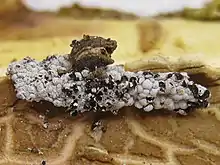| Diderma cinereum | |
|---|---|
 | |
| Scientific classification | |
| Domain: | Eukaryota |
| Phylum: | Amoebozoa |
| Class: | Myxogastria |
| Order: | Physarales |
| Family: | Didymiaceae |
| Genus: | Diderma |
| Species: | D. cinereum |
| Binomial name | |
| Diderma cinereum | |
Diderma cinereum is a species of slime mould in the family Didymiaceae, first described by Andrew Price Morgan in 1894,[1][2] from specimen(s) found in the Miami Valley on old wood and leaves.[2]
Description
Morgan describes it:
"Sporangia subglobose, more or less irregular, somewhat depressed, sessile, usually close or crowded, sometimes confluent; the hypothallus a thin membrane, pellucid or with occasional patches of lime granules, sometimes not apparent. The wall very thin, even or rugulose, cinereous, the thin membrane covered by a single layer of closely-adherent granules of lime, rupturing irregularly. Columella white, hemispheric or depressed and irregular, the surface granulose. Capillitium of very slender, colored threads, the extremities pellucid, more or less branched. Spores globose, minutely warted, violaceous, 9-11 mm. in diameter. Plate XII, Fig. 46.
Growing on old wood, leaves, etc. The sporangium .3-. 5 mm. in diameter, thin and smooth or rugulose. The species superficially greatly resembles Physarum cinereum."[2]
References
- ↑ "Diderma cinereum Morgan, 1894". www.gbif.org. Archived from the original on 20 January 2022. Retrieved 21 January 2022.
- 1 2 3 A.P. Morgan (1894). "The Myxomycetes of the Miami Valley, Ohio". The Journal of the Cincinnati Society of Natural History. 16: 154. ISSN 0885-3487. Wikidata Q110629794.